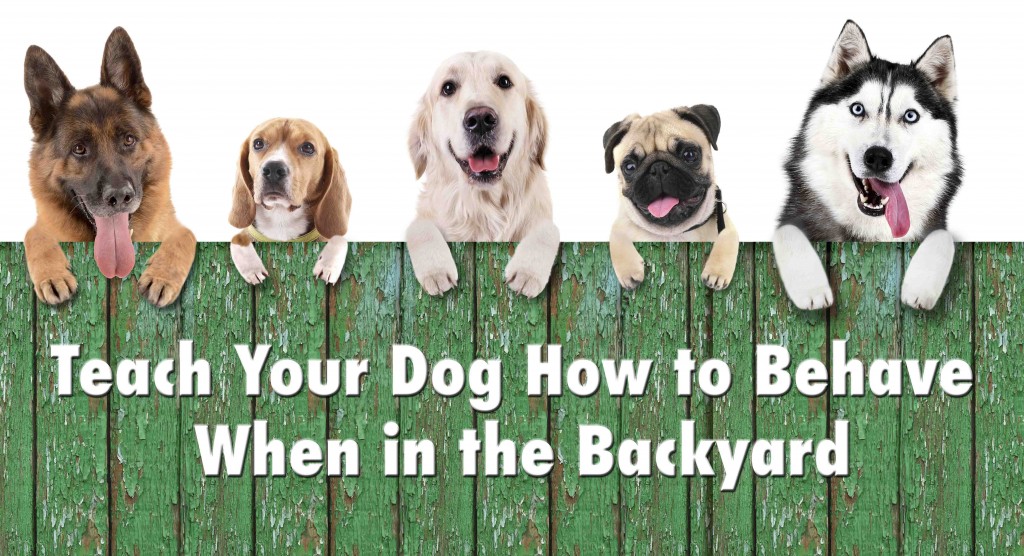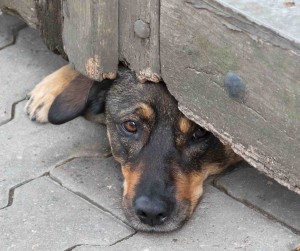 A lot of people take the precautions of keeping their new dog in a mistake free environment inside their house when left unattended until the dog can be trusted to have more freedom, but often neglect to take the same precautions when leaving their dog alone outside.
A lot of people take the precautions of keeping their new dog in a mistake free environment inside their house when left unattended until the dog can be trusted to have more freedom, but often neglect to take the same precautions when leaving their dog alone outside.
 Outdoor management, prevention and training is just as important as it is inside the house. In the same way your new dog can learn extremely undesirable behaviors while left alone in the house, like destroying your couch and ripping up your carpet, he can learn a number of undesirable and potentially dangerous habits while unattended in your yard. Some possibilities are digging holes, escaping from your yard, eating plants or debris, chewing on the side of your house or chewing on your outdoor furniture and belongings.
Outdoor management, prevention and training is just as important as it is inside the house. In the same way your new dog can learn extremely undesirable behaviors while left alone in the house, like destroying your couch and ripping up your carpet, he can learn a number of undesirable and potentially dangerous habits while unattended in your yard. Some possibilities are digging holes, escaping from your yard, eating plants or debris, chewing on the side of your house or chewing on your outdoor furniture and belongings.
Should you leave your dog unattended outside?
Where I live, it is potentially dangerous to leave a dog alone outside because of thieves, coyotes, mountain lions, bobcats, snakes, fire ants, scorpions, bee swarms, flies, wasps, and even birds of prey (for little dogs) so I do not suggest it to my clients. However, often people like to allow their dogs some time outside while they are home and able to check on their dog from time to time.
Some backyard and front yard situations can cause a dog to start reacting to people and dogs who pass. What can happen is that the reactions become more intense as time goes by to the point if the barrier were to suddenly no longer be there the dog could act aggressively. So in my opinion the safest place for a dog to be left unattended is in your house and that it is important to teach your dog how to behave when in your front or backyard.
I realize that in some parts of the world there are not these threats and that in some cultures dogs are not allowed inside the house. I wrote this article specifically for those who for some reason or another cannot keep their dog inside as I do get quite a lot of emails about this topic from people living in different parts of the world.
The solution to training a dog how to behave when unattended outside is the same as inside:
- Create a mistake free zone during the training process
During the training process, prevent your dog learning to do undesirable behavior when you are not around by keeping the dog in an accident-free environment. A large pen inside your house is preferable as your dog will be safe from the elements and not as likely to learn to bark at noises outside while you are away or distracted. If for some reason your only option is to keep your dog outside, I suggest that until the dog can be trusted to have free reign of your safe fenced yard, having your dog in a large escape-proof pen when unattended. For some dogs this might require an escape-proof top as well as a bottom. Inside the pen you can have a kennel with a bed, shade, fresh water, toys, chews, room to play, a toilet area, and a radio outside the pen to drown out noises. When you can trust your dog alone in the yard or inside your house you can get rid of the pen. Please use common sense, and do not leave dogs in unsafe environments. If your dog has separation anxiety seek help from a professional positive reinforcement trainer for help to teach your dog to spend time alone. The pen is a management solution as you train your dog to have more freedom. Keeping a dog in a pen all day is not the final goal. If you have to be away for long periods of time, have someone visit your dog to walk and interact with him.
- Teach your dog what you do want him to do when outside
o Encourage playing with toys and chewing on his bones
o Reinforce him with treats for laying on an outside dog bed
o Reinforce him with treats and attention for making good choices while outside
- Spend time outside with your dog and keep a close watch
Monitor your dog so you can interrupt undesirable behavior as soon as you can and redirect your dog to a more appropriate behavior. For example, use a kissy noise or recall, then get your dog interested instead in playing with a selection of toys that are already available to him. The focus of the training is on reinforcing your dog’s good choices. If you neglect to do this, your dog might learn to do undesirable things to get your attention.
- Avoid intimidation
Don’t use an angry voice or threaten with punishment, as what can happen is your dog can soon learn that when you are not around, doing undesirable behaviors are perfectly ok. By refraining from using intimidation your new dog will act the same way he does in front of you as he does when alone and this makes it easy to know when he’s ready to have more freedom when alone.
- Teach alone time outside systematically not haphazardly
When you feel like you can trust your dog, leave him outside for short periods of time, while you can watch through the window or watch on a camera. Then extend the time methodically. Make sure to go outside and interact with him often when he is making good choices, so that he doesn’t learn that he can get you to appear by digging or barking.
What about crates?
I think it’s a great idea to teach your dog to love resting in a crate so that you can use it in the car, for vet visits, or to give your dog a place to sleep when you bring your dog on outings. However, I don’t believe it is a good idea for dogs to spend many hours daily in an area that the only choice they can make is to get up or lay down. I believe that having a pen large enough that your new puppy or rescue dog can move around and make choices while you are gone will not only benefit your dog but benefit you as well. Your dog will have the opportunity to choose if he would like to lay in his kennel in a bed or on the cool floor. He will be able stretch his legs and play with toys while you are gone. This will make your dog less desperate for play and exercise when you return. I believe being in a pen better prepares dogs for what it will be like to be left alone loose in the house or yard, where a crate simply teaches them what to do when they have no choices.


0 Comments